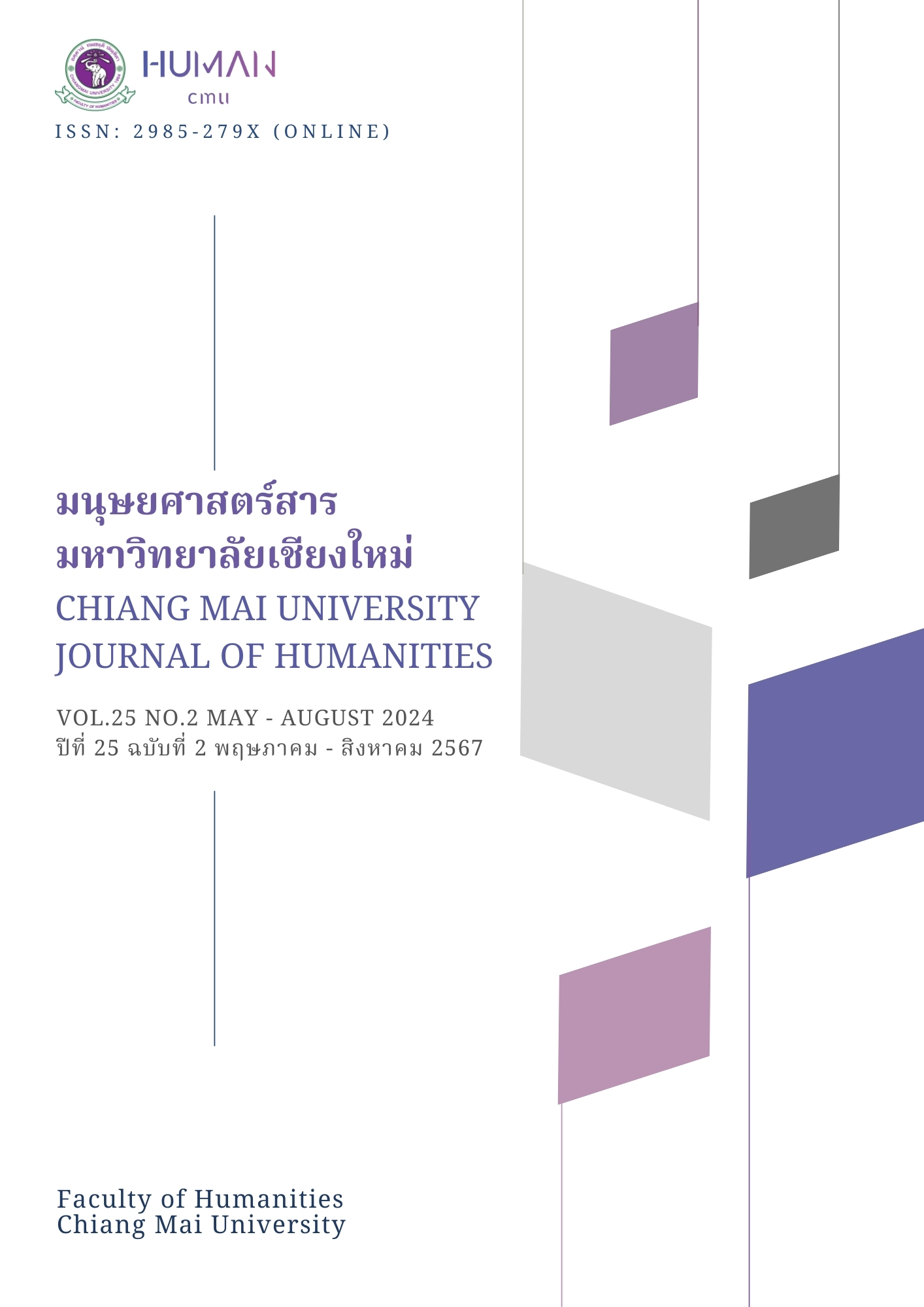Analyse phraséologique des séquences figées impliquant le terme « main » en français et “มือ” /mɯː/ en thaï
Main Article Content
บทคัดย่อ
Le présent article se propose d'analyser les séquences figées impliquant le terme « main » en français et “มือ” /mɯː/ en thaï, afin d'explorer les métaphores conceptuelles sous-jacentes dans ces expressions. Les parties du corps, particulièrement lorsqu'elles sont employées dans des expressions, revêtent une importance primordiale dans la communication humaine, car elles véhiculent souvent des représentations métaphoriques. Compte tenu des différences typologiques entre les deux langues, il est important d'examiner les similitudes et les différences dans les métaphores conceptuelles présentes dans ces séquences figées. De plus, les connotations spécifiques à chaque culture associées à ces expressions contribuent au sens littéral de celles-ci. En d'autres termes, les parties du corps peuvent véhiculer des sens métaphoriques distincts dans différentes langues et cultures, suscitant ainsi des réactions variées parmi des individus de divers horizons culturels. Au moyen d'une rigoureuse analyse basée sur une comparaison statistique de corpus des deux langues, nous avons mis en évidence plusieurs métaphores conceptuelles sous-jacentes aux séquences figées analysées. Ces résultats ont permis de mettre en lumière l'influence prépondérante des facteurs culturels, tels que les expériences de vie et les modes de pensée, dans les similitudes des métaphores conceptuelles utilisées dans les séquences figées somatiques.
Article Details

อนุญาตภายใต้เงื่อนไข Creative Commons Attribution-NonCommercial-NoDerivatives 4.0 International License.
เอกสารอ้างอิง
Ben-Henia Ayat, I. (2006). Degrés de figement et double structuration des séquences verbales
figées (Doctoral dissertation, Thèse de doctorat, Université Paris 13, Paris).
Burger, H. (1998) Phraseologie. Berlin: Erich Schmidt Verlag.
Cowie, A. P. (Ed.). (1998). Phraseology: Theory, analysis, and applications. OUP Oxford.
Fónagy, I. (1997). Figement et changements sémantiques. La locution entre langue et usages,
-164.
Gross, G. (1996). Les expressions figées en français: noms composés et autres locutions. Editions
Ophrys.
Jackendoff, R. (2008). ‘Construction after Construction’and Its Theoretical Challenges. Language,
-28.
Klein, J. R., & Lamiroy, B. (2011). Routines conversationnelles et figement. In Le figement
linguistique: la parole entravée (pp. 195-214). Honoré Champion.
Lakoff, G. (1987). The death of dead metaphor. Metaphor and symbol, 2(2), 143-147.
Lakoff, G., & Johnson, M. (1980). Metaphors we live by. University of Chicago press.
Lakoff, G., & Turner, M. (1989). More than cool reason: A field guide to poetic metaphor. University
of Chicago press.
Lamiroy, B. (2008). Le figement: à la recherche d’une définition. Zeitschrift für französische
Sprache und Literatur, 36, 85-99.
Lamiroy, B., & Klein, J. R. (2010). Les expressions verbales figées de la francophonie : Belgique,
France, Québec et Suisse. Editions OPHRYS.
Larousse. (2004). Dictionnaire de français Larousse. Repéré le 6 février 2023 à
https://www.larousse.fr/dictionnaires/francais
Marque-Pucheu, C. (2007). Les énoncés liés à une situation : mode de fonctionnement et mode
d’accès en langue 2. Hieronymus, I, 25-48.
Mejri, S. (1998). Le figement lexical : descriptions linguistiques et structuration sémantique.
L’information grammaticale, 76(1), 50-51.
Rey, A., & Chantreau, S. (2007). Le Robert Dictionnaire des expressions et locutions. Paris,
Dictionnaires le Robert.
Royal Institute. (2011). Le dictionnaire de l’Institut Royal B.E. 2554. 2nd Edition [พจนานุกรมฉบับ
ราชบัณฑิตยสถาน พ.ศ. 2554. พิมพ์ครั้งที่ 2]. Bangkok : Nanmeebooks Publication.
Royal Institute. (2012). Les expressions idiomatiques en thaï de l’Institut Royal. 2nd Edition.
[สำนวนไทย ฉบับราชบัณฑิตยสถาน พ.ศ. 2554. พิมพ์ครั้งที่ 2]. Bangkok : Tanapress Publication.
Steen, G. J., Dorst, A. G., Herrmann, J. B., Kaal, A. A., Krennmayr, T., & Pasma, T. (2010). A Method
for Linguistic Metaphor Identification: From MIP to MIPVU. Amsterdam: John Benjamins
Publishing Company.
Tutin, A. (2019). Phrases préfabriquées des interactions : quelques observations sur le corpus
CLAPI. Cahiers de lexicologie, 2019(114), 63-91.


